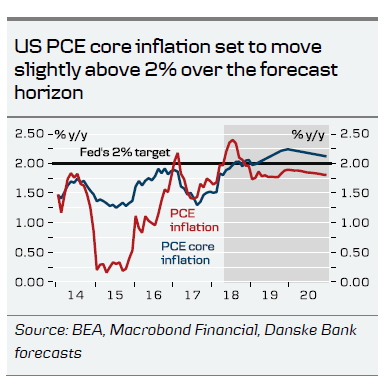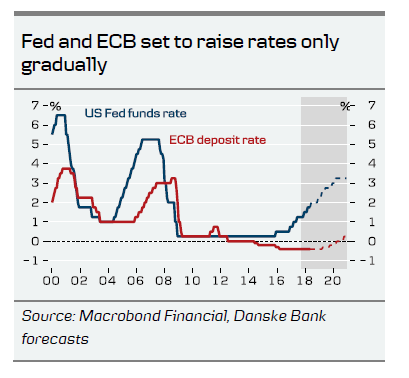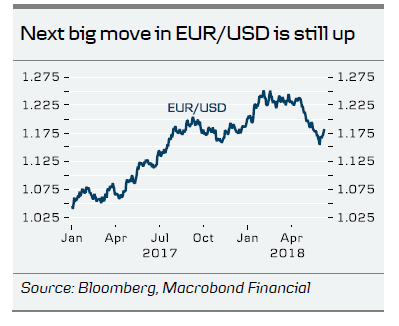Today’s key points
- Global growth has slowed but is set to stay above the potential growth rate.
- Volatility has increased but fundamentals support equities in 3-12M.
- Gradual monetary policy tightening amid muted inflation pressures.
- EUR/USD lower for longer but not forever.
From boom to cruising speed
Yesterday, we published our biannual The Big Picture, containing our updated macro forecasts for the global economy (see The Big Picture – From boom to cruising speed, 7 June). Following a strong end to 2017, we see clear signs that the business cycle is losing momentum. While global growth might be decelerating, we do not expect it to turn into a marked downturn over the next few years – rather, we believe growth in the world economy should go from boom to cruising speed in line with its potential. We expect global growth to come in at 3.8% this year, declining to 3.7% in 2019 and 3.6% in 2020.
The risks to our forecasts are skewed on the downside, from an escalation of trade tension into a full-blown trade war and a renewed Italian debt crisis. Unfortunately, the positive developments in the US-China trade conflict did not last long and the risk of renewed escalation over coming weeks has increased, as US President Trump has announced he will impose tariffs on USD50bn imports from China despite China having agreed to buy more US goods to bring down the trade balance (see US-China Trade Talks – Why things are getting tricky, 4 June. In Italy, markets are still waiting for indications of whether or not the new Five Star-League government will back down on some of its promises.
Higher volatility but fundamentals support equities
Last year was quite extraordinary, as growth rose across regions and risks diminished. Increasing economic growth, very high optimism among businesses and consumers and record-low volatility (as measured by the VIX index) were a good cocktail for equities, which rose steadily over the year. This year, with slower economic growth and more risks stemming from the political situation in Italy and the US-China trade conflict, it is not a big surprise that volatility has increased. However, as economic growth remains above potential and earnings growth is solid, we still expect equities to move higher but the ride is going to be bumpier than in 2017. Then again, it was 2017 that was extraordinary and we have just returned to a more ‘normal’ situation.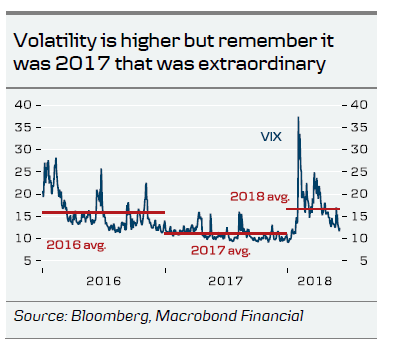
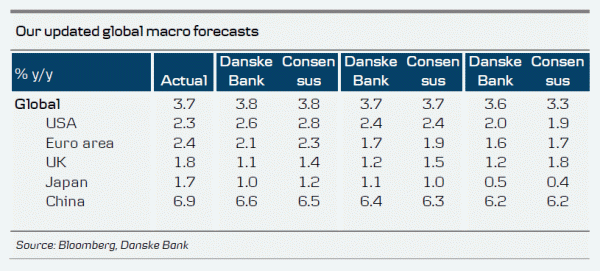
Gradual monetary policy tightening amid muted inflation pressure
Despite the expansion, especially in the US, having lasted for some time and the labour markets having tightened substantially, inflation and wage growth pressures remain modest. We believe some of the explanation is in the relatively muted inflation expectations and globalisation pressures. We believe the biggest upside risk to inflation is in the US, given its sizeable fiscal expansion and limited slack in the economy, and we think US PCE core inflation is set to move slightly above 2%, although it is likely to be a gradual process given that inflation is quite persistent in nature. The Federal Reserve is unlikely to panic by hiking aggressively on the back of this, as it has said it can accept core inflation moving slightly above 2% temporarily, as core inflation has run under the 2% target for a long time. While we think the Fed will raise the target range by 25bp to 1.75-2.00% next week, we do not think it will make big changes to its current policy strategy and still believe it is on track to deliver a total of three to four hikes this year
The expansion is a bit younger in Europe and the ECB is still fighting a tough battle against too low inflation relative to its 2% target. The ECB is still on track to end its QE programme this year but we think it is too early for Mario Draghi and the ECB to change their forward guidance at next week’s meeting, although the probability has increased since Chief Economist Peter Praet’s hawkish comments a couple of days ago. We expect the ECB to wait until July. In any case, the first ECB rate hike is still unlikely before the end of 2019, so in Europe we still expect to have a negative key policy rate over the next few years.
EUR/USD lower for longer but not forever
EUR/USD has been on a rollercoaster ride this year. It went above 1.25 in early February and reached its low at the end of May, slightly above 1.15. It has rebounded slightly since then and is currently trading a bit above 1.18. We have revised our EUR/USD forecast profile, as a hesitant ECB and USD carry is set to keep the cross lower for longer and EUR/USD does not seem to be heading back to the mid-.20s near term. We now see the cross at 1.17 in 1M, 1.17 in 3M (previously 1.19) and 1.20 (1.23) in 6M. We still believe the next big move remains higher though and think it will move to 1.25 in 12M (1.28). On a 6-12M horizon, we expect the ECB to end QE and believe forward guidance on rates will take centre stage. Although the first hike is distant, this should allow EUR/USD gravity to kick in, as the eurozone capital tide turns




